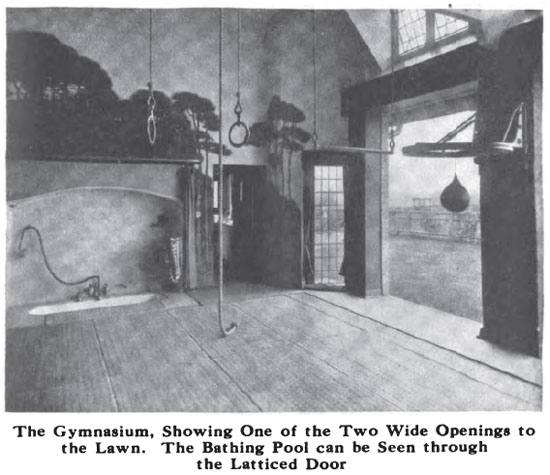- Originally published on the Bartitsu.org site on Thursday, 10th July 2014
These excerpts from the article “The Dwelling-House of an Apostle of Health” (“The House Beautiful”, Sept. 1909) offer a further glimpse inside the extraordinary dojo constructed in W.E. Steers’ Hilltop home in Surrey, England.
To explain the reasons for the inclusion of the beautifully designed gymnasium which is the great feature of the house, it should be noted that during his travels in Japan, Mr. Steers had been enormously impressed with the value of “jiu-jitsu” as a system of moral and physical training. He learned a little of the art in the Land of the Rising Sun; just enough to convince him of its great efficacy in developing all the powers of the body.
He saw, what so few people in England and America are aware of, that “jiu-jitsu” was not a mere method of wrestling, but that it formed the foundation of that extraordinary self-possession, coolness, and adroitness which are the mental as well as the physical attributes of the Japanese. He found that it was not a series of tricks which could be learned by an athletic man in the course of a few lessons; but that it was a highly developed system of education, the professors of which were as highly esteemed
in their own country as are those in western lands, who occupy the principal chairs at colleges and universities.
Hence the gymnasium at “Hilltop,” with its appliances for physical recreation. Several of the most prominent professors of “jiu-jitsu” have been over from time to time to instruct and exercise with the owner of this house of health on the hill. Among them may be mentioned Professor T. Tobari, one of the famous four who demonstrated before the Emperor of Japan the outstanding virtues of jiu-jitsu in comparison with other forms of physical culture, at a time when the government was deciding upon the best system to adopt for inclusion in the educational curriculums of the country.
The gymnasium is a room surrounded on three sides by walls painted to represent typical Surrey scenery as found in the neighborhood of Caterham. The mural decorative scheme was carried out by Mr. Hugh Wallis of Altrineham, Manchester. The fourth side is entirely open to the air and gives direct access on to a grassy exercising lawn, at one end of which is a plunge pool made of concrete and fitted with a spring-board. There are rolling shutters which can be drawn down when the owner is away or when tremendous storms of wind and rain drive in from the East.
The main floor of the gymnasium is constructed on springs like a dancing floor, with Japanese wrestling mats, two or three inches thick, surrounded by a thick cork carpet border, about two feet wide. A sunken bath with hot and cold water supply is fitted at one end of the room, and at the other is an arched fireplace recess. A door at the North end gives access to a dressing room and lavatory. Here the owner keeps his guns and revolvers, some of them being trophies of shooting contests. All the year round the gymnasium floor makes a splendid sleeping place; but Mr. Steers quite as frequently sleeps out on the lawn on a camp mattress.




